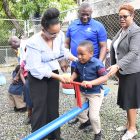Students and faculty members at the Spanish Town High School were greeted by major physical changes when they returned to start the new academic year. Thanks to the efforts of the Jamaica Automobile Association (JAA) Junior Club, they now have simulated roadways along some of the corridors.
The project — dubbed ‘Know the Road, Know the Code’ — has outfitted the corridors and hallways throughout the school with broken and unbroken lines, which simulate the road markings for pedestrian crossings at intersecting corridors and directional signs.
Saffrey Brown, Jamaica National (JN) Foundation’s GM said, “The aim is to sensitise students to the importance of being aware of road safety rules and signs that will empower them to practise and display better road use behaviour.”
“Our goal is to get our students so familiar with the rules of the road and how to use them properly, so that as pedestrians, and when they eventually become motorists, the signs will be second nature,” Brown explained.
The idea for the initiative was framed by William Hill, project officer for the JAA Junior Club, with help from Rushawn Nembhard, former president of the JAA Junior Club at the school.
Loretta Collins, Spanish Town High vice-principal, said the school operates on a two-shift system and had no standard directions for the movement of more than 2,450 students around the campus.
“The one-way signs and dual walkways will streamline the flow of persons in any direction,” she explained.
Established in 1967, the school is located at the intersection of Young and Ellis streets.
Howard Carr, auto mechanic instructor and liaison teacher for the JAA Junior Club, said, “Our expectation is that students will obey the directions on the signs; and where a sign indicates “one way”, it encourages movement in one direction. On that basis, students will be inculcated to use the rules of the road in our corridors.”



